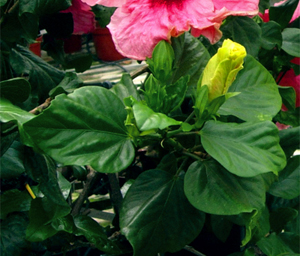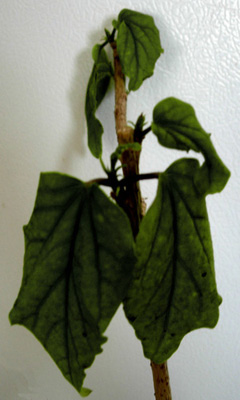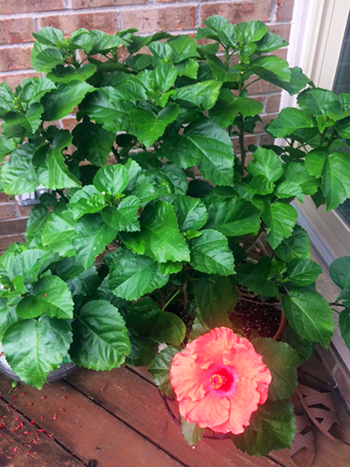Hibiscus Plant Care
Wilt Disease
My Hibiscus Leaves are all Green, but Wilting and Dying!
What Should I do?
Most hibiscus pests and diseases are not fatal and can be easily cured, but hibiscus wilt disease is one that can be scary, because it can kill an entire plant in an amazingly short time.
What Causes Hibiscus Wilt Disease?
 Healthy Hibiscus Leaves Stand Out Crisply |
How do I Know my Hibiscus has Wilt Disease?
Although the leaves slowly wilt and die in wilt disease, they usually do not turn yellow, which makes wilt disease an easy problem to spot. Almost all other hibiscus problems cause the leaves to turn yellow. But with wilt disease, the leaves will tend to stay the green they were to begin with, or they may slowly darken as they wilt to a dark green, brown, or blackish color. Wilt disease will also hit the entire plant, not just one tip or branch. If just one tip or branch is wilted, then your plant has dieback disease, which can be cured but pruning away the damaged branch, but not the dreaded wilt disease. For wilt disease, look for wilting green leaves all over your plant, or all over one entire side of your plant.
 Wilted Green Leaves ~ Hibiscus Wilt Disease |
Prevention ~ The Best Cure!
If none of your plants have wilt disease, then learn how to prevent it now! Prevention is by far the easiest and best cure for wilt disease, and it's an important part of keeping hibiscus healthy. Wilt disease is by far the most common cause of hibiscus loss - we get email several times a year from heartbroken hibiscus lovers whose plant is dying of wilt disease. Just the time it takes to send and receive an email can be long enough for the disease to kill the plant, so learning to prevent wilt disease in the first place is clearly the wisest course of action.
Follow these steps to help keep your hibiscus free of wilt disease:
- Do not overwater! Adjust watering to match the season and the weather. In summer hibiscus need frequent watering, often daily, but in cooler times they need much less water. Fungi love soggy, wet soil, and if you keep your hibiscus too wet, you are inviting fungi to grow there. Most wilt disease strikes in winter when gardeners fail to reduce watering enough and the soil stays too wet and cool.
- Keep your pots clean. Remove dead leaves and flowers from both the plant and the pot.
- Control insects, as they can spread disease and make wounds in the plant that pathogens can enter.
- When transplanting, try not to wound the plant, as such wounds are entry points for pathogens.
- Do not overfertilize or fertilize when the soil mix is dry, as this can burn the roots and make the plant more vulnerable to attack.
- Use a growth enhancer on a regular schedule to help keep hibiscus immune systems strong enough to fight off wilt disease in the initial stages. This new preventative treatment is looking very promising.
- Apply worm castings to the surface of the potting mix, working it into the mix as best you can. Start with a layer that is 1/2" - 1" of castings on the surface of the potting mix. Or mix it into the potting mix before potting up, using about 1 part castings to 5 parts potting soil. This has reduced our problems with wilt of young transplants at HVH to almost zero. (If you use HVH Potting Mix, it comes pre-mixed with worm castings.)
- Apply Rootshield/Plantshield beneficial fungi according to label directions. This material is similar to the worm castings but perhaps more potent and targeted to disease problems.
- Optional, but recommended for those with continuing disease problems: in Fall and again in Spring drench your pots with fungicides. Use Phyton (copper based) or any product containing thiophanate methyl, such as Cleary's 3336, Domain, Medallion, or Fungo, or any other fungicide recommended by your local agriculture extension office. It will help to remove or suppress fungi. (Although Subdue Maxx is recommended by some, we do not recommend it, as it is specific only for other types of fungi that do not usually cause wilt disease in hibiscus.)
Help! I Already Have Wilt Disease! What do I do?
If your hibiscus is fully wilted, you may not be able to save it. But it's still worth a try! The treatment for a wilting hibiscus is not difficult. It's almost identical to the treatment for any other kind of hibiscus stress. Anyone can do it quickly and easily. Just keep these directions handy, and use them at the very first sign of wilting on any of your plants:
Directions for Saving a Wilting Hibiscus
- Get your hibiscus out of the sun quickly!
- If it's in a pot, move it to a place that has bright shade, but no direct sunlight at all.
- If it's in the ground, try to create some shade for it with a tarp, umbrella, or tree branch.
- If it's in the house, move it away from any sunny windows.
- If possible, try to move it to a place that is warm and protected from the wind and nighttime cold.
- Fill some kind of spray bottle with water and mist your plant really well. Try to wet all the leaves well, but avoid misting the soil if it is already wet.
- Check the leaves quickly.
- If any leaves are very yellow, remove them so the plant doesn't have to waste energy dropping them off.
- Leave all green leaves on the plant, even if they are wilted. Green leaves can still photosynthesize, and may spring back up to health.
- Do NOT transplant! Leave in the original pots or spot in the ground.
- Do NOT prune or cut in any way!
- Do NOT water until the soil is a bit dry on the surface, then water only a little bit:
- If you have SuperNova Growth Enhancer, use a double dose of it in a small amount of water, or
- If you have HVH Houseplant Formula, use a normal dose of it in a small amount of water.
- If you don't have either of these emergency products, then use ONLY PLAIN WATER.
- Do NOT use any other products or fertilizers! Fertilizer creates more stress for a wilting plant.
- Mist your hibiscus every day. Try to really wet down all sides of all the leaves. The extra hydration will take some stress off the roots while the plant recuperates. Continue misting daily until you see active growth.
 This hibiscus bounced back quickly! It is crisp and healthy after only 2 weeks of treatment. Other hibiscus will take 2-3 months, so be patient! |
Continue this treatment until the leaves crisp back up and you see new active green growth for at least 2 weeks. Then slowly start inching your hibiscus back toward the sun, and gradually start adding regular fertilizer into the plant water. If you see any signs of wilt return, go back to the wilt instructions again.
You will need to be patient. Some hibiscus will bounce back from the early stages of wilt in 1-2 weeks, but if often takes longer. It took us 3 full months to cure one of our most beloved hibiscus plants that got caught in a winter freeze! But after those 3 months, the plant went back to the greenhouse where it is now bigger and healthier than ever. So this does work if you just keep following the protocol patiently until your sick plant fully recovers.
What if Only a Branch or Two are Wilted?
 A hibiscus with only 2 tiny wilted branches. Take this wilt seriously! It can spread rapidly and kill the whole plant! |
If you see only a branch or two that are wilted, you will need to figure out what is going on. If the tips of the branches are black, then this is called dieback and it is safe to just cut off the sick branches. But if the tips are green, as in the photo at right, then this is early stages of Wilt Disease, and you need to do the full treatment above very, very quickly! This kind of wilt can spread overnight and quickly kill your whole plant. So take it just as seriously as you would take a whole plant that is wilted.
Remember, the key to successfully saving a hibiscus with wilt disease is speed! If you're running out the door to go to work and spot a sick plant, just pull it quickly out of the sun. Or throw an umbrella over it if it's in the ground outside. Protecting it from the sun will hold it for a few hours while you work, then you can complete the rest of the treatment when you get home. Most hibiscus will respond quickly if you treat quickly, so keep your eye out for wilting as cold weather comes, and be prepared with either SuperNova Growth Enhancer or HVH Houseplant Formula on hand as part of your hibiscus first aid kit.